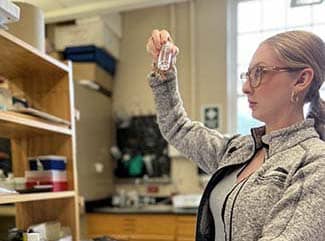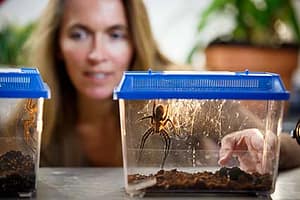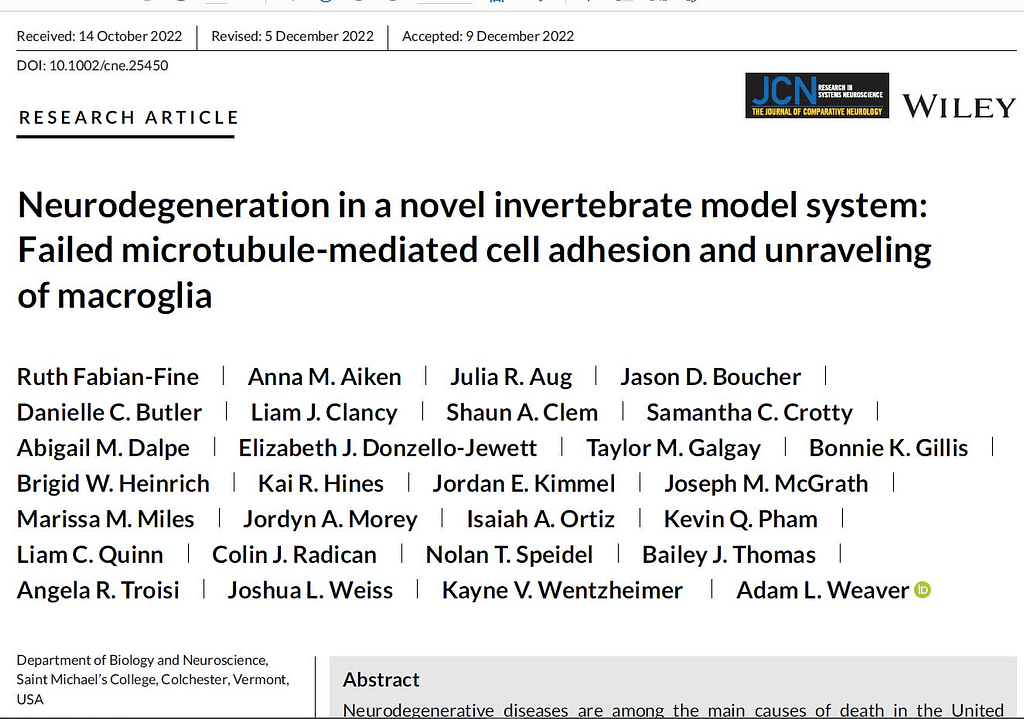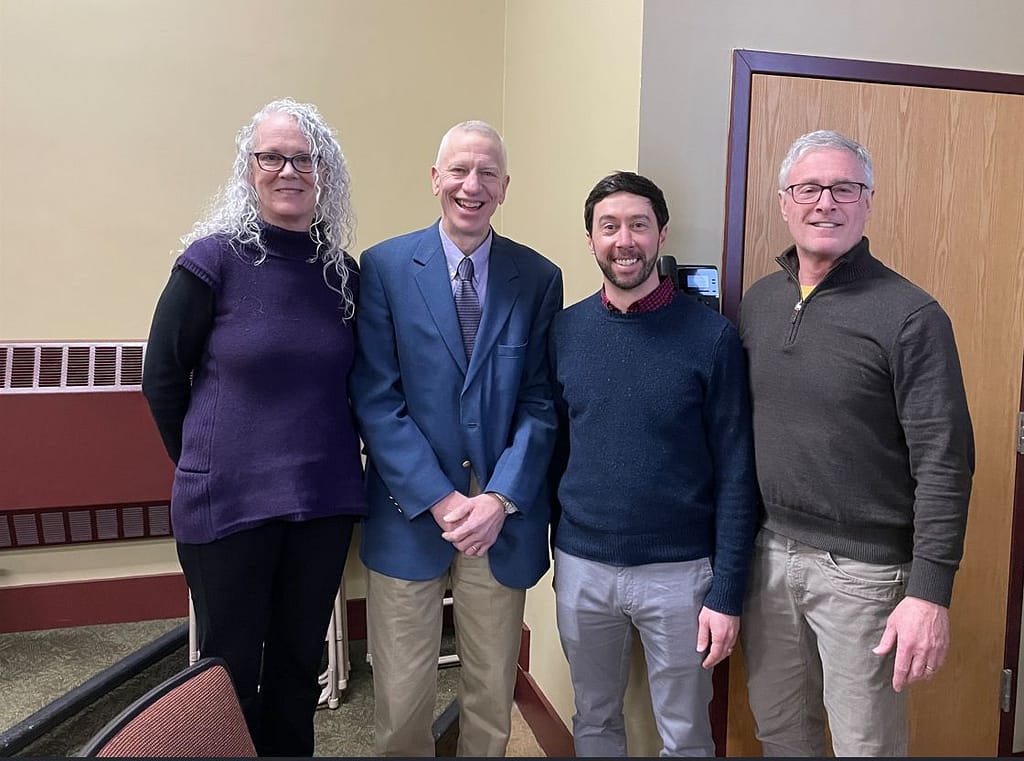Student researchers are co-authors on published paper in science journal
Professors Ruth Fabian-Fine and Adam Weaver mentor 26 from neuroscience classes in work leading to impressive undergraduate credentials
Co-authoring a published paper recently for a respected science journal with their faculty mentors was a rare and valuable opportunity for 26 Saint Michael’s College student researchers to gain a résumé credential more typical for graduate students.

Ruth Fabian-Fine
In early January, Professors Ruth Fabian Fine (lead author) and Adam Weaver of the College’s biology/neuroscience faculty had a paper published in the Journal of Comparative Neurology on the topic of neurodegeneration.
The publication lists the professors’ undergraduate researchers as co-authors at the start of the paper. For undergraduates aspiring to science careers, such a prominent role and acknowledgement on a paper is uncommon, said the mentor professors — neither of whom saw their first publishing credits on such a paper until they were graduate students.
Fabian-Fine said this latest shared achievement reflects a trend in the Saint Michael’s Cellular/Molecular Research Lab to involve a steadily growing number of students more deeply in professionally significant work.
“What this says about the program here at Saint Michael’s is that hopefully we have created a strong team spirit in which students have found a ‘home base’ to which they come back to continue this work,” she said. “It is also that this activity is beneficial for their résumés and increases their likelihood to be accepted to postgraduate programs.”

Adam Weaver
More specifically, the paper describes neurodegeneration in the professors’ spider model system, which involves extensive lab work and analysis from their student co-authors. The full title is “Neurodegeneration in a novel invertebrate model system: Failed microtubule-mediated cell adhesion and unraveling of macroglia.”
Students of the Cellular/Molecular Research Classes of 2021 and 2022 named as co-authors are: Anna M. Aiken, Julia R. Aug, Jason D. Boucher, Danielle C. Butler, Liam J. Clancy, Shaun A. Clem, Samantha C. Crotty, Abigail M. Dalpe, Elizabeth J. Donzello-Jewett, Taylor M. Galgay, Bonnie K. Gillis, Brigid W. Heinrich, Kai R. Hines, Jordan E. Kimmel, Joseph M.McGrath, Marissa M. Miles, Jordyn A. Morey, Isaiah A. Ortiz, Kevin Q. Pham, Liam C. Quinn, Colin J., Radican, Nolan T. Speidel, Bailey J. Thomas, Angela R. Troisi, Joshua L.Weiss, and Kayne V. Wentzheimer.
Taylor Galgay ’24, a junior neuroscience major from Windsor, VT, said participating in research at Saint Michael’s College has been the biggest influence on her desire to continue research and further develop her knowledge.
“Working under the enthusiastic mentorship of Professors Fabian-Fine and Adam Weaver has made it easy to fall in love with research and be self-assured in my work,” Galgay said. “Something valuable that I learned from research and the process of getting published is to be more confident in myself and our findings. The process of having your paper peer-reviewed is rigorous and it’s important to not be discouraged by the process and to stay confident in your data and findings.”
Fabian-Fine and Weaver said it is too early yet to have received feedback yet from the research and science community on their hypothesis from the published paper, and their work in any case is ongoing. “We will now investigate the molecular processes that cause degeneration onset with the goal to ultimately identify ways to prevent this from happening,” Fabian-Fine said.

Taylor Galgay ’24 works in a Cheray Science Hall lab at Saint Michael’s College earlier this year.
The professors and their students additionally made a major presentation in the McCarthy Recital Hall about the content of the paper as part of the fall’s Solutions for Social Impact seminar series.
Fabian-Fine emphasized the benefits for her students to have such credentials on their résumés. “When I write letters of support for these students, I list this publication and provide the link to the student seminar presentation,” she said. “Over the past years our research students have had close to 100 percent acceptance rate to their postgraduate positions they have applied to. Most of them aspire to go into the medical field or go into biomedical research.”
The group of student co-authors ranged from first-year students to seniors, she said, so many students have the chance to stay involved in the same project over a more extended period than is typical in undergraduate research situations.
One longer-term goal and hope of the ongoing spider neurodegeneration research at Saint Michael’s is that it might speed breakthroughs in treating Alzheimer’s and dementia and other conditions

Professor Fabian-Fine with her spiders used in ongoing research on neurodegeneration, from a file photo of several years ago.
“Most (functional) discoveries in neuroscience have been made in model systems [such as the spider model system at Saint Michael’s] –,for instance, how the action potential works, how receptors work, signaling pathways, transmitter systems and so forth.” Fabian-Fine has teamed up with the University of Vermont Medical School and is “currently processing human brain samples to investigate if I can make similar observations in human brain as we have in the spider brain.”
From the abstract about this paper in the publication comes this more detailed summary of the work:
“Neurodegenerative diseases are among the main causes of death in the United States, leading to irreversible disintegration of neurons. Despite intense international research efforts, cellular mechanisms that initiate neurodegeneration remain elusive, thus inhibiting the development of effective preventative and early onset medical treatment. To identify underlying cellular mechanisms that initiate neuron degeneration, it is critical to identify histological and cellular hallmarks that can be linked to underlying biochemical processes. Due to the poor tissue preservation of degenerating mammalian brain tissue, our knowledge regarding histopathological hallmarks of early to late degenerative stages is only fragmentary. Here, we introduce a novel model organism to study histological hallmarks of neurodegeneration, the spider Cupiennius salei. We utilized toluidine blue-stained 0.9-μmserial semithin and 50-nm ultrathin sections of young and old spider nervous tissue. Our findings suggest that the initial stages of neurodegeneration in spiders may be triggered by (1) dissociation of neuron- and glia-derived microtubules, and (2) the weakening of microtubule-associated desmosomal junctions that lead to the unraveling of neuron-insulating macroglia, compromising the structural integrity of affected neurons. The involvement of macroglia in the disposal of neuronal debris described here—although different in the proposed transport mechanisms—shows resemblance to the mammalian glymphatic system. We propose that this model system is highly suitable to investigate invertebrate neurodegenerative processes from early onset to scar formation and that this knowledge may be useful for the study of neurodegeneration in mammalian tissue.”
The image below shows the start of the published version of the article from the journal, with the student co-author names visible.






